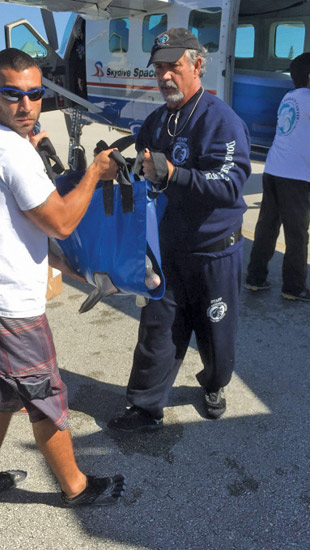Made trip in Caravan’s kiddy pool
The notice came across the Pilots N Paws forum in early January: “FL Marathon to Clearwater; Number of animals being transported: 1; Breeds, weight, age: small dolphin.”
 Most pilots who fly four-seat airplanes might have paused and then clicked on to the next listing, knowing that their airplanes couldn’t possibly handle an aquatic mammal—even a small one. The usual request is to fly dogs, cats, and sometimes rabbits, birds, and reptiles to new homes.
Most pilots who fly four-seat airplanes might have paused and then clicked on to the next listing, knowing that their airplanes couldn’t possibly handle an aquatic mammal—even a small one. The usual request is to fly dogs, cats, and sometimes rabbits, birds, and reptiles to new homes.
This request was a first, although volunteer pilots have in the past flown sea turtles and even two small donkeys. The animal in need was named Summer, a dolphin that had been discovered stranded as an infant on July 4, 2014, on Redington Beach, Florida. Summer was initially taken in by Clearwater Marine Aquarium, a rescue facility in Clearwater, Florida.
Successfully rehabilitated, rescuers knew the young dolphin could not live on her own in the ocean and needed transport—along with four humans—to the Dolphin Research Center in Grassy Keys, Florida. Dolphin Research Center’s mission in part is to provide permanent homes for dolphins and sea lions that can’t live in the wild.
“I saw the post come up and my mind was thinking through the logistics,” said Robert Gaynor, a relatively new Pilots N Paws volunteer. “I’ve been a dolphin lover my whole life.”
Gaynor, who owns and flies a Piper Archer that he keeps at Boca Raton Airport, knew his airplane wasn’t up to the mission—but he started making phone calls and talking to people. He initially spoke with a friend who owns a jet, but realized that the jet wouldn’t be sufficient to carry the 76-pound dolphin, her caregivers, and the necessary equipment. He then contacted the owner of Skydive Spaceland-Florida at Airglades Airport in Clewiston, Florida.
The owner offered a pilot and the use of a Cessna Caravan to transport Summer and her support crew, asking only to be reimbursed for fuel.
Dolphin Research Center personnel “covered the entire plane with plastic,” laid down a 10-foot by six-foot children’s pool, filled it with water, and made sure the temperature was at exactly 81 degrees. Summer’s support crew included two veterinarians as well as two handlers in wetsuits who lay in the pool with her. Oxygen, ultrasound equipment, and a crash cart with EKG rounded out the payload.
“They had logs they were keeping on every breath she took,” Gaynor said. “It was amazing to watch it happen.”
“She will spend time in our medical pool, gradually becoming acclimated to water from Florida Bay, before she moves into the dolphin lagoons,” the Dolphin Research Center said on its website. “This will also give her time to become accustomed to her human caregivers, who will then introduce her to her new dolphin family.” The Dolphin Research Center is hopeful that some of its adult dolphins will accept Summer into their care. A wild dolphin generally spends one to three years with its mother.
Email [email protected]
Image: Courtesy Rob Gaynor



